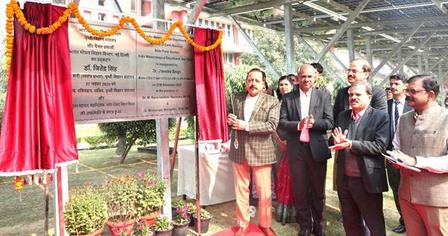
Centre Launches 2 New C-Band Doppler Weather Radars, Solar Panel System, And Meteorological Museum
Dr Jitendra Singh, Union Minister of State (Independent Charge) for Science & Technology, who launched the initiatives, noted that the IMD is rapidly implementing the dream project 'Mission Mausam', which the Prime Minister Narendra Modi dedicated to the nation during IMD's 150-year celebrations in January this year.
“We had committed to expand the radar count from 47 to almost three times by 2027, but I am happy to share that within just a few months, we have already reached 126 radars. We still have two years to go, and I am confident that we will not only meet but comfortably achieve the target well within the timeline,” Singh said.
The dual-polarised, solid-state power amplifier-based C-Band Doppler weather radar installed at Indira Gandhi Krishi Vishwavidyalaya, in Chhattisgarh's Raipur, can detect monsoon depressions, low-pressure systems, heavy rainfall, thunderstorms, lightning, hailstorms, squalls, and turbulence with a 250-km radial coverage.
Its observational reach extends over Chhattisgarh, interior Odisha, eastern Madhya Pradesh, southwest Jharkhand, and the southern parts of East Uttar Pradesh, filling a long-standing data gap and significantly improving IMD's prediction capabilities in these regions.
The second radar, installed at IMD's RS/RW Office in Shakthi Nagar, Mangaluru, Karnataka, will provide advanced monitoring of severe weather systems, including cyclones, thunderstorms, squalls, heavy rainfall, lightning, hailstorms, and turbulence.
With 250 km coverage, the radar will monitor the Arabian Sea adjoining Karnataka, areas of Goa and South Konkan, northern Lakshadweep, and land regions of Karnataka, Kerala, Goa, and South Maharashtra.
The Meteorological Museum, designed to inspire students, researchers, and the youth, will showcase IMD's journey over 150 years.
The museum features historic weather instruments, upper-air observational systems, communication tools, radar, and satellite components, and offers audio-visual facilities for interactive learning.
Singh encouraged IMD to conduct structured educational tours for school and college students, calling the museum a“journey down a century of scientific evolution.”
In alignment with India's clean energy mission, IMD also installed a 771 kWp solar power system across the Mausam Bhawan Complex, comprising 1,315 solar panels installed through NBCC.
Singh said the initiative supports national goals under the PM Surya Ghar Muft Bijli Yojana, contributes to India's net-zero commitments, and sets a model for other government buildings.
“IMD has now achieved over 50 per cent radar coverage, and is planning additional radars, including urban radars in Delhi, Chennai, Mumbai, and Kolkata, and advanced phased-array radars for the Himalayan states of Jammu and Kashmir, Uttarakhand, and Himachal Pradesh,” said Dr. M. Ravichandran, Secretary, Ministry of Earth Sciences.

Legal Disclaimer:
MENAFN provides the
information “as is” without warranty of any kind. We do not accept
any responsibility or liability for the accuracy, content, images,
videos, licenses, completeness, legality, or reliability of the information
contained in this article. If you have any complaints or copyright
issues related to this article, kindly contact the provider above.


















Comments
No comment